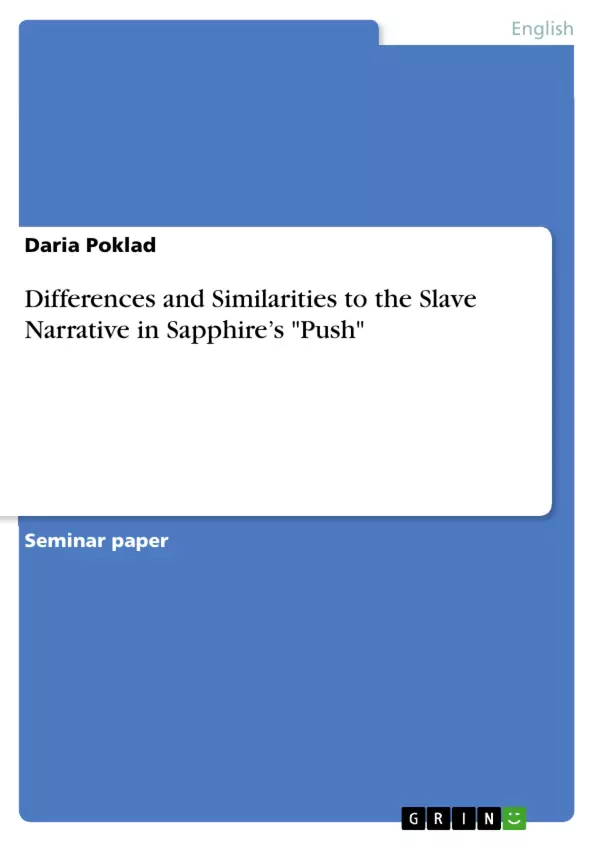The research question of this essay is, to what extend can features of a slave narrative be incorporated into a contemporary novel as "Push" and which features have to be altered in order to reflect specific cultural realities. Sapphire’s first novel (1996) is told in the African American vernacular voice of obese and illiterate 16-year-old Claireece Precious Jones who lives with her abusive mother in Harlem. The novel begins with Precious being pregnant with her second child by her father, who has been repeatedly raping her since childhood. After being expelled from high school due to her pregnancy, she is placed in an alternative school program where she learns to read and write with a group of other young women. As she becomes literate, her life begins to change.
Of the several essays written on "Push" most authors have focused on topics such as race and social class, food consumption and obesity, disability and the female body, rape, incest and trauma as well as on the topic of transformation. Only Riché Richardson has established a relationship between "Push" and the slave narrative in his essay “Close Up: Push, Precious, and New Narratives of Slavery in Harlem” by showing recurring slave narrative motifs including “Precious’ detachment from her mother and father, her sexual and physical abuse, and her quest for literary and freedom” (163).
In this essay, I will go a step further and not only focus on the similarities between "Push" and the slave narrative, but also discuss which impact the differences such as the replacement of the antebellum South into an urban setting and the replacement of slave holders into abusive and exploiting parents have on the narrative. I will begin the essay with a contextual chapter on the genre of slave narrative and its defining features. Then, I will focus on Sapphire’s "Push" and illustrate the differences to a slave narrative focusing on the urban setting of Harlem and the parents as tormentors. In a next step, I will discuss the similarities between "Push" and the slave narrative focusing on the themes of abuse and exploitation, as well as literacy, transformation and finally on escaping and being a free member of society.
Inhaltsverzeichnis (Table of Contents)
- Introduction
- The Genre of the Slave Narrative
- Differences to the Slave Narrative
- The Urban Perspective
- Black Parents Instead of White Masters and the Depiction of Sexual Abuse
- Similarities to the Slave Narrative
- The Theme of Abuse and Exploitation
- Literacy
- The Transformation of Precious Jones
- Escaping and Becoming a Free Member of Society
- Conclusion
Zielsetzung und Themenschwerpunkte (Objectives and Key Themes)
This essay explores the extent to which elements of the slave narrative genre are incorporated into the contemporary novel "Push" by Sapphire and examines the necessary alterations to reflect specific cultural realities. It aims to analyze the similarities and differences between "Push" and the slave narrative tradition, focusing on the impact of urban setting, parental abuse, and other key themes.
- The adaptation of the slave narrative genre in a contemporary context
- The portrayal of urban life and its impact on the narrative
- The theme of abuse and exploitation in both the slave narrative and "Push"
- The role of literacy and its transformative power
- The concept of escaping oppression and achieving freedom
Zusammenfassung der Kapitel (Chapter Summaries)
The essay begins with an introduction to the genre of the slave narrative, outlining its origins and key characteristics. It then focuses on "Push" and analyzes the differences to a traditional slave narrative, highlighting the urban perspective of Harlem and the role of abusive parents as tormentors. Subsequent sections explore the similarities between "Push" and the slave narrative, examining the shared themes of abuse and exploitation, the significance of literacy, the transformative journey of Precious Jones, and her eventual escape to freedom.
Schlüsselwörter (Keywords)
Key themes and concepts explored in this essay include: slave narrative genre, urban setting, parental abuse, exploitation, literacy, transformation, escape, freedom, contemporary African American literature, "Push" by Sapphire.
- Quote paper
- Daria Poklad (Author), 2015, Differences and Similarities to the Slave Narrative in Sapphire’s "Push", Munich, GRIN Verlag, https://www.grin.com/document/314028



